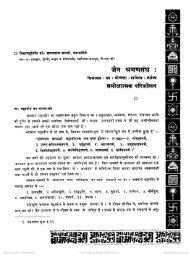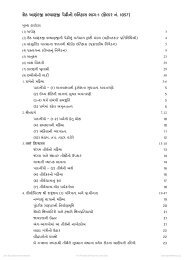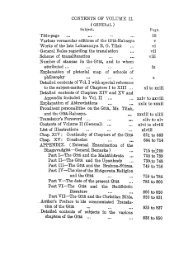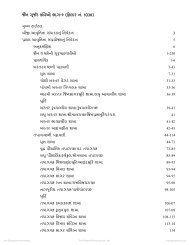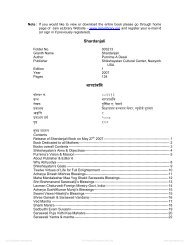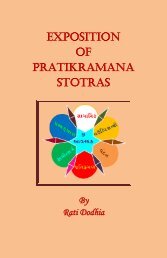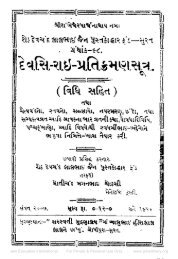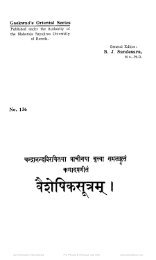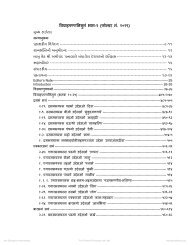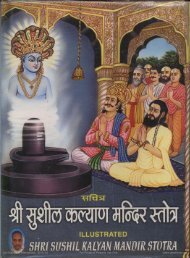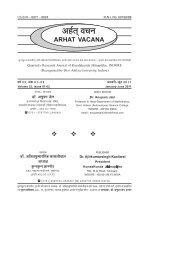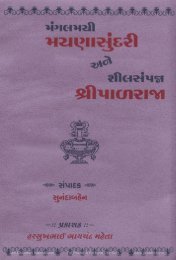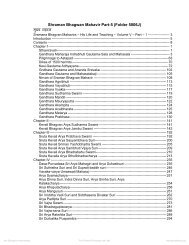Different Samvatsary Days in Svetambar Tradition:
Different Samvatsary Days in Svetambar Tradition:
Different Samvatsary Days in Svetambar Tradition:
Create successful ePaper yourself
Turn your PDF publications into a flip-book with our unique Google optimized e-Paper software.
1<br />
September 4, 2012<br />
Historical Perspective of Samvatsari Day and Ja<strong>in</strong> Calendar<br />
Introduction<br />
Prav<strong>in</strong> K Shah<br />
Ja<strong>in</strong>a Education Committee<br />
Ja<strong>in</strong>a Director<br />
The discussion about the Samvatsari Day and Ja<strong>in</strong> Calendar is always a very sensitive issue. It<br />
requires careful research and <strong>in</strong>terpretation. The article presented here is not to hurt any Ja<strong>in</strong><br />
sect or its practices but to explore the subject objectively.<br />
Almost every year when we celebrate Paryushan and Samvatsari day, there is some confusion<br />
and disagreement on what day to observe Samvatsari day and annual forgiveness Pratikraman<br />
among various Ja<strong>in</strong> sects. This year non-murtipujak Ja<strong>in</strong>s celebrated Paryushan about one<br />
month earlier than most of the murtipujak Ja<strong>in</strong>s of Digambar and Swetambar sects.<br />
Several times <strong>in</strong> the past, the Murtipujak Ja<strong>in</strong> community was divided <strong>in</strong>to two groups and<br />
celebrated Samvatsari day on two separate days <strong>in</strong> India, USA, and other places.<br />
The past 120 years of documented history <strong>in</strong>dicates that about 12 times the Shvetämbar<br />
Murtipujak Ja<strong>in</strong> community was divided on the authenticity of the Samvatsari Tithi. This has<br />
created disappo<strong>in</strong>tment and concern among the youth <strong>in</strong> North America who are very sensitive to<br />
the issue of open m<strong>in</strong>dedness and of Ja<strong>in</strong> Unity.<br />
In order to understand the issue better, about 25 years ago years ago we started look<strong>in</strong>g <strong>in</strong>to the<br />
history of the Ja<strong>in</strong> calendar and how the Tithis or <strong>Days</strong> are def<strong>in</strong>ed <strong>in</strong> the Ja<strong>in</strong> calendar. We have<br />
discussed this topic with many Ja<strong>in</strong> scholars and ascetics and researched various articles on this<br />
subject over this time period.<br />
As we learned more about the creation of the various Ja<strong>in</strong> calendars and the differences that<br />
exist among them, we realized that this knowledge should be documented such that the North<br />
American Ja<strong>in</strong> community will have some understand<strong>in</strong>g of the limitations that exist <strong>in</strong> and among<br />
various Ja<strong>in</strong> sects and their Ja<strong>in</strong> calendars and hence <strong>in</strong> calculation of religious pious days.<br />
This article summarizes our research of the history of Ja<strong>in</strong> calendars, calculations of the date of<br />
various pious days (Parva Tithis), Samvatsari, Deeväli, and New Year day as def<strong>in</strong>ed <strong>in</strong> the<br />
present Ja<strong>in</strong> calendar. This article is also available <strong>in</strong> pdf format at the follow<strong>in</strong>g l<strong>in</strong>k and we will<br />
cont<strong>in</strong>ue to update the article periodically if needed:<br />
Ja<strong>in</strong> Calendar<br />
http://www.ja<strong>in</strong>elibrary.org/elib_master/$samvatsari_day/<br />
The Ja<strong>in</strong> calendar (Panchäng) is a “Lunisolar” calendar. It is based on the position of the Moon<br />
with respect to the Earth and it is adjusted by add<strong>in</strong>g an extra month once every three years, to<br />
co<strong>in</strong>cide with the SUN to br<strong>in</strong>g month <strong>in</strong> phase with the season. Its day or date which is known<br />
as Tithi, <strong>in</strong>dicates the moon phase and the month <strong>in</strong>dicates the approximate season of the solar<br />
year.<br />
The lunisolar calendar has the follow<strong>in</strong>g arrangement:<br />
A regular or normal year has 12 months; a leap year has 13 months.<br />
A regular or normal year has 353, 354, or 355 days; a leap year has 383, 384, or 385<br />
days.<br />
The average number of days <strong>in</strong> a month is 30 but the average number of days <strong>in</strong> a Lunisolar year<br />
is 354 and not 360 (12 months <strong>in</strong> a year) because it takes the Moon about 29.5 days (not 30<br />
days) to complete the circle around the Earth. Hence one Tithi is elim<strong>in</strong>ated <strong>in</strong> about duration of<br />
two months.
The Jewish (Hebrew), H<strong>in</strong>du lunar, Buddhist, and Tibetan calendars are all lunisolar, and<br />
so were the Japanese calendars until 1873 and the Ch<strong>in</strong>ese calendars until 1912.<br />
The Islamic calendar is a pure Lunar Calendar because its date (Tithi) <strong>in</strong>dicates the moon<br />
phase but its months are not <strong>in</strong> phase with the time of the solar year or the season. It<br />
does not adjust its calendar to co<strong>in</strong>cide with the SUN or the season. Hence no extra<br />
month is added every three years.<br />
The Gregorian calendar (English CE) is a pure Solar Calendar and its date <strong>in</strong>dicates the<br />
time of the solar season but not the moon phase.<br />
Tithi (Day or Date)<br />
In a Lunisolar calendar the day or date is recognized as Tithi. The angular distance (measured<br />
anticlockwise) between the Sun and Moon as measured from the Earth can vary between 0° and<br />
360°. This is divided <strong>in</strong>to 30 parts (normally 30 days <strong>in</strong> a month). Each part ends at 12°, 24° and<br />
so on. The circle ends at 360°. The time spent by the Moon <strong>in</strong> each of these parts (i.e. the time<br />
taken for the angular distance to change by 12°) is called one Tithi (This is a very simple<br />
explanation. In reality the calculation is quite complex because the Earth and the Sun have<br />
moved their position dur<strong>in</strong>g this time and the value changes to close to 13 degree).<br />
Each Lunisolar month has two Paksha-s or fortnights (15 Tithis or days <strong>in</strong> a fortnight). The first<br />
15 Tithi-s constitute the bright fortnight or Shukla or Sud Paksha and the next 15 Tithi-s constitute<br />
the dark fortnight or Krishna or Vad Paksha. The Tithi-s are <strong>in</strong>dicated by their Paksha and ord<strong>in</strong>al<br />
number with<strong>in</strong> the Paksha.<br />
The days are not labeled separately from number one to thirty as <strong>in</strong> the solar calendar, but the<br />
Tithi is their only label and each Tithi has a unique name. The 15th Tithi of the bright fortnight or<br />
Sud (Full Moon Day) is called Purnimä and the 15th Tithi of the dark fortnight or Vad (Dark Moon<br />
or New Moon Day) is called Amävasyä.<br />
The duration of a day (between the two consecutive Sunrises) is approximately 24 hours.<br />
However the duration of each Tithi varies between 22 hours and 26 hours because the Moon<br />
rotates around the Earth <strong>in</strong> a slightly tilted position and hence the angular velocity is not constant<br />
with respect to the particular location of the Earth (This is also a very complex calculation).<br />
Structure of Ja<strong>in</strong> Calendar as per Ägam Literature<br />
The Ja<strong>in</strong> Ägam literature (ref - Chandra Prajnapti and Surya Prajnapti) def<strong>in</strong>es a five year cycle of<br />
a Ja<strong>in</strong> calendar. This is known as one Yuga. In the Ja<strong>in</strong> Ägamic calendar<br />
(1) One “Tithi” is elim<strong>in</strong>ated after every 61 days<br />
(2) An additional month is added after every 30 months.<br />
(3) Dur<strong>in</strong>g a five year cycle, the month of Posha (the 3 rd month of the current Ja<strong>in</strong> calendar) is<br />
added after 30 months and the month of Ashädh (the 9 th month) is added after 60 months.<br />
This description <strong>in</strong>dicates that none of the current Ja<strong>in</strong> calendars published by various Ja<strong>in</strong> sects<br />
are based on Ja<strong>in</strong> Ägam literature.<br />
Also there is a strong <strong>in</strong>dication <strong>in</strong> the Ägamic calendar, that the Ja<strong>in</strong> calendar year ended on<br />
Ashadha Sud 15 and the New Year beg<strong>in</strong>s on Shravan Vad 1 as per Rajasthani calendar nam<strong>in</strong>g<br />
convention or Ashadha Vad 1 as per Gujarati calendar nam<strong>in</strong>g convention (see-the follow<strong>in</strong>g<br />
note).<br />
Note - Differences <strong>in</strong> Nam<strong>in</strong>g Convention between Rajasthani and Gujarati<br />
Calendar<br />
In the Rajasthani calendar, the duration of the Month is the time between the two Full Moons<br />
(Purnimä). When a Full Moon occurs before sunrise, then the day that beg<strong>in</strong>s at Sunrise is said<br />
to be the first day of the Lunisolar month. Hence the month starts with Vad “Tithi” – decl<strong>in</strong><strong>in</strong>g<br />
moon phase - and ends with Sud “Tithi” – Ris<strong>in</strong>g Moon phase. This convention is followed not<br />
only <strong>in</strong> Rajasthan but also <strong>in</strong> a major part of India.<br />
2
In the Gujarati calendar, the duration of a Month is the time between two New Moons or Dark<br />
Moons (Amavas). When a New Moon occurs before sunrise, then the day that beg<strong>in</strong>s at Sunrise<br />
is said to be the first day of the Lunisolar month <strong>in</strong> the Gujarati calendar. Hence the month starts<br />
with Sud “Tithi” – Ris<strong>in</strong>g Moon phase – and ends with Vad “Tithi” – decl<strong>in</strong><strong>in</strong>g moon phase.<br />
Dur<strong>in</strong>g the Sud Tithi period, the names of Rajasthani and Gujarati calendar months are the same<br />
but dur<strong>in</strong>g Vad Tithi period the names of the Rajasthani months are one month ahead of the<br />
Gujarati month.<br />
Example – Dur<strong>in</strong>g the month of Ashädh – the Sud period, both calendars will have the same<br />
name of the month. But dur<strong>in</strong>g Vad period, the Gujarati calendar will <strong>in</strong>dicate Ashädh Vad 1; the<br />
same day <strong>in</strong> Rajasthani calendar is called as Shravan Vad 1 and so on. Hence Sud months are<br />
the same <strong>in</strong> both calendars but dur<strong>in</strong>g Vad months, the name of month <strong>in</strong> Rajasthani calendar is<br />
one month ahead.<br />
Ext<strong>in</strong>ction of Ja<strong>in</strong> Ägamic Calendar<br />
The description of the Ägamic Ja<strong>in</strong> calendar exists only <strong>in</strong> the Ja<strong>in</strong> Ägam literature and Ja<strong>in</strong>s may<br />
have used it orally probably dur<strong>in</strong>g the first five hundred to 1000 years after Tirthankar Bhagawän<br />
Mahävir’s Nirvana. Ja<strong>in</strong> Ägams were written approximately 1000 years after Lord Mahävir’s<br />
nirvana and s<strong>in</strong>ce then there is no record available that some one had used or pr<strong>in</strong>ted the Ja<strong>in</strong><br />
Ägamic calendar.<br />
The follow<strong>in</strong>g may be the probable causes of ext<strong>in</strong>ction of the Ja<strong>in</strong> Ägamic Calendar:<br />
The Ägamic Ja<strong>in</strong> calendar was not <strong>in</strong> l<strong>in</strong>e with the popular H<strong>in</strong>du (Laukik or Lokik)<br />
calendar because Diwäli and New Year days <strong>in</strong> the Ja<strong>in</strong> calendar were different than <strong>in</strong><br />
the H<strong>in</strong>du calendar. Sometimes one month apart.<br />
The social activities like birth, marriage, and death ceremonies of the Ja<strong>in</strong> community<br />
were always performed by the H<strong>in</strong>du priests and the Ja<strong>in</strong> community be<strong>in</strong>g <strong>in</strong> m<strong>in</strong>ority<br />
always celebrated the local religious holidays with H<strong>in</strong>du community (Similar to<br />
celebration of Xmas holidays here <strong>in</strong> USA).<br />
The usage of the Ja<strong>in</strong> Ägamic calendar was very limited to religious activities like<br />
Samvatsari (Paryushan) and so on.<br />
The Ja<strong>in</strong> laymen may have lost the knowledge of the calculation of Tithis us<strong>in</strong>g the Moon<br />
and the Sun position as described <strong>in</strong> the Ja<strong>in</strong> Ägams (as many fam<strong>in</strong>es occurred dur<strong>in</strong>g<br />
this time).<br />
Adoption of a H<strong>in</strong>du Calendar as a Ja<strong>in</strong> Calendar<br />
Every religion needs its own calendar for the operation and celebration of its pious (religious)<br />
days as well as for the celebration of social events. In the absence of an authentic Ja<strong>in</strong> calendar,<br />
the Ja<strong>in</strong> Ächäryas adopted a H<strong>in</strong>du Lunisolar calendar as a basis to create a new Ja<strong>in</strong> calendar.<br />
The H<strong>in</strong>du Lunisolar calendar is based on the position of the Moon (Moon phase) at the time<br />
of Sunrise. The cities on different latitudes will have different Sunrise time and hence different<br />
Moon phases. So the H<strong>in</strong>dus do not have one unique lunisolar calendar among all H<strong>in</strong>dus<br />
through out India or through out the world but different cities have different H<strong>in</strong>du Lunisolar<br />
calendars.<br />
However, this was not practical for the m<strong>in</strong>ority Ja<strong>in</strong>s to have different Ja<strong>in</strong> calendars for different<br />
cities of India. Hence, probably around 1500 years ago, the Ja<strong>in</strong> Ächäryas decided to use the<br />
H<strong>in</strong>du calendar of the city of Jodhapur; Rajasthan (India),popularly known as the Candasucand<br />
calendar as a basis to create a new Ja<strong>in</strong> calendar.<br />
To convert the H<strong>in</strong>du calendar <strong>in</strong>to a Ja<strong>in</strong> calendar, certa<strong>in</strong> changes were made to the Jodhapur<br />
H<strong>in</strong>du calendar to dist<strong>in</strong>ctly identify Ja<strong>in</strong> religious days and its religious needs. Presently it is<br />
done <strong>in</strong> the same way but some sects have changed the city from Jodhapur to Mumbai. These<br />
changes are def<strong>in</strong>ed later <strong>in</strong> this article.<br />
3
Structure of H<strong>in</strong>du Calendar<br />
Def<strong>in</strong>ition of Tithi (Day) <strong>in</strong> H<strong>in</strong>du Calendar<br />
In the H<strong>in</strong>du calendar, the day starts with the local sunrise and the position of the Moon (Moon<br />
phase) at that time decides the Tithi (known as Udaya Tithi). This Tithi is applied for the entire<br />
day even if the Moon phase may change to the next Tithi a few m<strong>in</strong>utes after Sunrise. This<br />
concept of Tithi <strong>in</strong> the H<strong>in</strong>du calendar is different from the Ja<strong>in</strong> Ägamic calendar. The Tithi is not<br />
connected with the Sunrise (Udaya Tithi) <strong>in</strong> the Ja<strong>in</strong> Ägamic calendar.<br />
Kshaya Tithi (Lost Tithi ) and Vriddhi Tithi (Extra Tithi)<br />
S<strong>in</strong>ce <strong>in</strong> the H<strong>in</strong>du calendar the Tithi is def<strong>in</strong>ed at the time of Sunrise, several times <strong>in</strong> a year a<br />
condition occurs that the same Tithi may exist between two consecutive Sunrises because dur<strong>in</strong>g<br />
24 hours the Moon phase did not change more than 12 degrees. This is called Vriddhi (extra)<br />
Tithi.<br />
Similarly several times <strong>in</strong> a year a situation occurs that one Tithi (Moon phase) does not touch<br />
any Sunrise time at all. This is known as Kshaya (loss) Tithi.<br />
This happens because the duration of each Tithi varies between 22 hours and 26 hours and the<br />
duration between the two consecutive Sunrises is about 24 hours.<br />
Please note that only Kshaya Tithi occurred <strong>in</strong> the Ägamic Ja<strong>in</strong> calendar but the H<strong>in</strong>du<br />
calendar has both Kshaya (loss) and Vriddhi (extra) Tithi several times <strong>in</strong> a year. However<br />
the total number of days <strong>in</strong> a year rema<strong>in</strong>ed the same <strong>in</strong> both Ja<strong>in</strong> and H<strong>in</strong>du Calendars.<br />
Leap Year (13 months <strong>in</strong> a Year)<br />
As expla<strong>in</strong>ed before, both the Ja<strong>in</strong> and H<strong>in</strong>du calendar has an extra month added once every<br />
three years which br<strong>in</strong>gs seasons <strong>in</strong> phase with the month duration. Even though both the H<strong>in</strong>du<br />
and Ägamic Ja<strong>in</strong> calendars are Lunisolar calendars, they used different leap year calculation<br />
methods. In the H<strong>in</strong>du calendar, any of the 12 months can be a leap month while the Ägamic<br />
Ja<strong>in</strong> calendar def<strong>in</strong>es a five year time cycle (known as Yuga) <strong>in</strong> which the month of Posha (mid-<br />
year month of an ancient Ja<strong>in</strong> Calendar) and Ashadha (the last month of an ancient Ja<strong>in</strong><br />
calendar) are only two leap months.<br />
Changes made to the H<strong>in</strong>du Calendar:<br />
Ja<strong>in</strong> Parva Tithis (Pious <strong>Days</strong>)<br />
Ja<strong>in</strong> Ächäryas have def<strong>in</strong>ed Tithis; 2, 5, 8, 11, 14, and 15 as pious or Parva Tithis or Parva days<br />
<strong>in</strong> both the Sud and Vad part of the Moon cycles of every month. People take special vows and<br />
perform various penances (Ärädhanä) on these days. To fulfill their Ärädhanä without any<br />
<strong>in</strong>terruptions of Kshaya (lost) or Vriddhi (extra or double) Tithi, the ancient Ja<strong>in</strong> literature has<br />
<strong>in</strong>dicated some special rules to apply to the H<strong>in</strong>du calendar def<strong>in</strong>ed <strong>in</strong> the follow<strong>in</strong>g Gätha or<br />
Sutra:<br />
“Kshaye Purva Tithi Kärya, Vridhhau Karya Tathottara;<br />
Shri Veer J<strong>in</strong>a Nirvanam, Karyma Lokanugairih:”<br />
If a Kshaya or Vriddhi Tithi occurs on a Parva Tithi (pious day) <strong>in</strong> the H<strong>in</strong>du calendar, follow the<br />
follow<strong>in</strong>g rules for the conversion to Ja<strong>in</strong> calendar:<br />
In case of Kshaya (loss) Tithi, previous Tithi should be considered as Ja<strong>in</strong> Parva Tithi<br />
In case of Vriddhi (double) Tithi, the 2 nd Tithi should be considered as Ja<strong>in</strong> Parva Tithi<br />
Do not change Mahavir Nirvana Day (Deepävali day) as def<strong>in</strong>ed <strong>in</strong> the H<strong>in</strong>du calendar.<br />
Also this rule <strong>in</strong>directly told us that we cannot change the leap month of the H<strong>in</strong>du<br />
calendar.<br />
This is how the Ja<strong>in</strong> calendar is created us<strong>in</strong>g above rules apply<strong>in</strong>g to H<strong>in</strong>du Calendar.<br />
Practically the follow<strong>in</strong>g changes were made <strong>in</strong> the Jodhapur H<strong>in</strong>du calendar.<br />
4
In case of Kshaya (loss) Tithi of 2, 5, 8, 11, 14, and 15, make Kshaya of Tithi; 1, 4, 7, 10,<br />
13, and also 13 respectively for Ja<strong>in</strong> calendar.<br />
In case of Vriddhi (double) Tithi of 2, 5, 8, 11, 14, and 15; make Vriddhi (double) of Tithi;<br />
1, 4, 7, 10, 13, and also 13 respectively.<br />
One can see that <strong>in</strong> case of Kshaya or Vriddhi Tithi of pious days <strong>in</strong> the H<strong>in</strong>du calender, the Ja<strong>in</strong><br />
calendar has simply changed the previous Tithi as a Kshaya or Vriddhi Tithi.<br />
Also when Tithi 15 was either Kshaya or Vriddhi, the rule def<strong>in</strong>ed <strong>in</strong> the Gätha was applied twice<br />
and made 13 as a Kshaya or Vriddhi Tithi.<br />
This way the pr<strong>in</strong>ted Ja<strong>in</strong> calendar will not have any Kshaya or Vriddhi pious Tithis. The common<br />
people will not have any confusion about Parva Tithis to carry out their Ärädhanä of religious<br />
vows and penances.<br />
Also <strong>in</strong> the new Ja<strong>in</strong> calendar, the last day of the year is Äso Vad 15 (Amas) as per Gujarati<br />
nam<strong>in</strong>g convention or Kärtik Vad 15 (Amas) as per Rajasthani nam<strong>in</strong>g convention. Mahävirswami’s<br />
nirvana day rema<strong>in</strong>ed same as it appeared <strong>in</strong> the H<strong>in</strong>du calendar. This way the Ja<strong>in</strong><br />
community can celebrate their social and religious Parva days (which are compromised), on the<br />
same day as H<strong>in</strong>dus celebrate Deepävali days.<br />
Paryushan Parva and Samvatsari Day<br />
Accord<strong>in</strong>g to Ja<strong>in</strong> Ägam literature, the history of Paryushan Parva is more than 2000 years old.<br />
However there is no clear <strong>in</strong>dication of the actual number of Paryushan Parva days and the exact<br />
Tithi of Samvatsari day. Accord<strong>in</strong>g to Kalpa sutra only a day of Samvatsari (one day only) is<br />
called Paryushan.<br />
The Ja<strong>in</strong> tradition <strong>in</strong>dicates that monks can not stay at one place for more than 30 days.<br />
However <strong>in</strong> India dur<strong>in</strong>g the four months of the ra<strong>in</strong>y season, from Ashadha Sud 15 to Kärtik Sud<br />
15, they must stay at one place to m<strong>in</strong>imize violence that would occur <strong>in</strong> travel<strong>in</strong>g dur<strong>in</strong>g the ra<strong>in</strong>y<br />
season.<br />
In ancient times, the monks are required to f<strong>in</strong>d a suitable place to stay at one place for the ra<strong>in</strong>y<br />
season by Ashädh Sud 15 which is the last day of the ancient Ja<strong>in</strong> Ägamic calendar year and<br />
also before the beg<strong>in</strong>n<strong>in</strong>g of the ra<strong>in</strong>y season. They perform annual Samvatsari Pratikraman on<br />
Ashädh Sud 15 (ref - Nishitha Bhäsya Sutra) and start the New Year on the next day which is<br />
Shrävan Vad 1 as per Rajasthan nam<strong>in</strong>g convention or Ashädh Vad 1 as per Gujarati nam<strong>in</strong>g<br />
convention.<br />
If the monks cannot f<strong>in</strong>d a suitable place by Ashädh Sud 15 then they may cont<strong>in</strong>ue to travel to<br />
f<strong>in</strong>d a suitable place for up to 50 days (this may be called as a grace period). However they must<br />
f<strong>in</strong>d a place and settle dur<strong>in</strong>g this time period and then do Samvatsari Pratikraman.<br />
Even if they do not f<strong>in</strong>d a suitable place dur<strong>in</strong>g the grace period of 50 days, they must still do the<br />
Samvatsari Pratikraman under a tree on the 50 th day but not violate the 50 day limit for<br />
Samvatsari Pratikraman (ref – Ja<strong>in</strong> Ägams - Samaväyänga and Nishitha Sutras). The 50 th day<br />
from Ashädh Sud 15 falls on Bhadarva Sud 5.<br />
S<strong>in</strong>ce Bhädarvä Sud 5 was the last day for Samvatsari Pratikraman, it seems that to keep Ja<strong>in</strong><br />
the community united and properly organized, probably around the 7 th to 10 th century time Ja<strong>in</strong><br />
Ächäryas may have decided to do Samvatsari Pratikraman only on Bhadarva Sud 5 <strong>in</strong>stead of<br />
earlier as <strong>in</strong>dicated <strong>in</strong> Ja<strong>in</strong> Agamic literature.<br />
Before that one may conclude from the ancient literature that monks may be do<strong>in</strong>g Samvatsari<br />
Pratikraman any time between Ashädh Sud 15 and Bhadarva Sud 5 and the common people<br />
jo<strong>in</strong>ed with the monks for the Samvatsari Pratikraman.<br />
5
Change of Samvatsari Day from Bhadarva Sud 5 to 4:<br />
Ancient Ja<strong>in</strong> literature (ref - Nishitha Bhäsya Churni and Kalpa Sutra Tikä) <strong>in</strong>dicates the follow<strong>in</strong>g<br />
story as the primary reason for chang<strong>in</strong>g the Samvatsari day from Bhadarva Sud 5 to 4 by the<br />
Shvetämbar Ja<strong>in</strong> Murtipujak Tapa-gachchha sect which is about 70% of the total Ja<strong>in</strong> population.<br />
As the k<strong>in</strong>g of Ujjay<strong>in</strong>i was the enemy of Ja<strong>in</strong> religion, Ja<strong>in</strong> Ächärya Kälak had to migrate<br />
immediately from the town of Ujjay<strong>in</strong> after his arrival, to f<strong>in</strong>d a suitable place to stay for the ra<strong>in</strong>y<br />
season. The Ächärya left the town and traveled dur<strong>in</strong>g the beg<strong>in</strong>n<strong>in</strong>g days of the ra<strong>in</strong>y season.<br />
He may have arrived at the town of Pratisthanpur near the end of the 50 days which is close to<br />
Bhadarva Shud 5.<br />
After reach<strong>in</strong>g Pratisthanpur, he decided to do Samvatsari Pratikraman on Bhadarva Sud 5. The<br />
k<strong>in</strong>g Satavahan of Pratisthanpur, who was a Ja<strong>in</strong> k<strong>in</strong>g, <strong>in</strong>formed the Ächärya that the whole town<br />
would be celebrat<strong>in</strong>g a major social event known as Indra-Mahotsav on Bhadarva Sud 5 and<br />
therefore he may not be able to jo<strong>in</strong> for the Samvatsari Pratikraman. He requested the Ächärya<br />
to do Samvatsari Pratikraman on the next day which was Bhadarva Sud 6.<br />
The Ächärya <strong>in</strong>dicated that the monks must do annual Pratikraman by Bhadarva Sud 5. So to<br />
accommodate the k<strong>in</strong>g’s request he changed the Samvatsari Pratikraman Tithi to Bhadarva Sud<br />
4 (one day earlier) for that year and the K<strong>in</strong>g agreed to jo<strong>in</strong> on that day.<br />
We do not have any knowledge of what happened <strong>in</strong> the follow<strong>in</strong>g year as to whether the Ja<strong>in</strong><br />
community cont<strong>in</strong>ued to do Samvatsari on Bhadarva Shud 4 or on 5. Some literature <strong>in</strong>dicates<br />
that Ächärya Kälak may have died before the next Samvatsari day.<br />
However, later on (I could not f<strong>in</strong>d any documented record) the Shvetämbar Murtipujak Ja<strong>in</strong><br />
community (mostly Tapa-gachchha sect) started do<strong>in</strong>g Samvatsari Pratikraman on Bhadarva Sud<br />
4. They provide one reason – s<strong>in</strong>ce we have done Pratikraman one day earlier <strong>in</strong> the past, we<br />
need to cont<strong>in</strong>ue that way and can not go back because Samvatsari Pratikraman must be done<br />
with<strong>in</strong> a year but not one year + one day (I cannot f<strong>in</strong>d this rule <strong>in</strong> ancient Ja<strong>in</strong> scripture).<br />
New Problem Surfaced due to the Change of Samvatsari Day<br />
The orig<strong>in</strong>al Samvatsari Tithi of Bhadarva Sud 5 is a Parva Tithi (pious day). Now the new Tithi –<br />
Bhadarva Sud 4 – which was not a Parva Tithi before, became an additional Parva Tithi only for<br />
the month of Bhädarvä. For all other months, shud 4 rema<strong>in</strong>ed an ord<strong>in</strong>ary Tithi. Hence the<br />
follow<strong>in</strong>g situations may occur <strong>in</strong> some future Ja<strong>in</strong> calendar.<br />
If <strong>in</strong> a particular year, Bhadarva Sud 5 becomes a Vriddhi (double) Tithi <strong>in</strong> the Jodhapur<br />
H<strong>in</strong>du calendar, then <strong>in</strong> the Ja<strong>in</strong> calendar Bhadarva Sud 4 can not become a Vriddhi Tithi<br />
because it is now a Parva Tithi (new Samvatsari day). We need to make Bhadarva Sud<br />
3 as a Vriddhi Tithi (the rule def<strong>in</strong>ed <strong>in</strong> above Gätha is applied twice as is done <strong>in</strong> case of<br />
15). By do<strong>in</strong>g this we have delayed the Samvatsari day by one day.<br />
If <strong>in</strong> a particular year, Bhadarva Sud 5 becomes Kshaya (loss) Tithi, then aga<strong>in</strong> Bhadarva<br />
Sud 4 can not be a Kshaya Tithi but we need to make Bhadarva Sud 3 as a Kshaya Tithi.<br />
This will br<strong>in</strong>g the actual Samvatsari day one day earlier.<br />
In both the situations, we disturb the new Samvatsari day - Bhadarva Sud 4. The clear solution is<br />
not def<strong>in</strong>ed <strong>in</strong> the Ja<strong>in</strong> literature. Also these types of the problems were not visible <strong>in</strong> old times<br />
because people at various towns may have been do<strong>in</strong>g Samvatsari Pratikraman anytime between<br />
Ashädh Sud 15 and Bhadarva Sud 4 or 5 when monks decide to stay dur<strong>in</strong>g the ra<strong>in</strong>y season.<br />
However the first time the problem surfaced was <strong>in</strong> the year 1896 (H<strong>in</strong>du year 1952). A Kshaya<br />
Tithi of Bhadarva Sud 5 occurred <strong>in</strong> the Jodhapur H<strong>in</strong>du calendar.<br />
Some Swetambar Ja<strong>in</strong> Ächäryas suggested that we should not disturb Bhadarva Sud 4 and solve<br />
the problem by accept<strong>in</strong>g another H<strong>in</strong>du calendar <strong>in</strong> which Kshaya of Bhadarva Sud 6 was found.<br />
Other Ächäryas did not agree with the change it is not proper to change the Jodhapur H<strong>in</strong>du<br />
calendar every time such situation arises. They <strong>in</strong>sisted that we should cont<strong>in</strong>ue to use the same<br />
6
calendar and make Bhadarva Shud 3 as a Kshaya Tithi. Hence, for the first time, the<br />
Shvetämbar Murtipujak Ja<strong>in</strong> community observed Samvatsari on two separate days <strong>in</strong> that year.<br />
For the past 120 years, s<strong>in</strong>ce 1896 (H<strong>in</strong>du year 1952) to 2005 (H<strong>in</strong>du year 2061), twelve times<br />
Bhadarva Sud 5 was either Kshaya Tithi or Vriddhi Tithi <strong>in</strong> the H<strong>in</strong>du calendar.<br />
The follow<strong>in</strong>g list summarizes the occurrence of the above situation.<br />
Year CE H<strong>in</strong>du Year<br />
1896 1952 Bhadarva Sud 5 Kshaya<br />
1905 1961 Bhadarva Sud 5 Kshaya<br />
1933 1989 Bhadarva Sud 5 Kshaya<br />
1936 1992 Bhadarva Sud 5 Vriddhi<br />
1937 1993 Bhadarva Sud 5 Vriddhi<br />
1948 2004 Bhadarva Sud 5 Kshaya<br />
1957 2013 Bhadarva Sud 5 Kshaya<br />
1958 2014 Bhadarva Sud 5 Kshaya<br />
1972 2028 Bhadarva Sud 5 Kshaya<br />
1977 2033 Bhadarva Sud 5 Kshaya<br />
1986 2042 Bhadarva Sud 5 Kshaya<br />
2005 2061 Bhadarva Sud 5 Vriddhi<br />
In all of the above years, the Shvetämbar Ja<strong>in</strong> Murtipujak community was divided <strong>in</strong> India and<br />
performed Samvatsari Pratikraman on two separate days. To resolve this problem, Ja<strong>in</strong><br />
Ächäryas, other learned monks and scholars had about 9 major conferences from 1920 to 1988<br />
(H<strong>in</strong>du year 1976 to 2044).<br />
In the year 1958 (H<strong>in</strong>du year 2014), the H<strong>in</strong>du calendar had Bhadarva Sud 5 Kshaya.<br />
Shvetämbar Murtipujak Tapa-gachchha Ja<strong>in</strong> Sangh decided to let go of the Jodhapur H<strong>in</strong>du<br />
calendar and adopted the Janma-Bhumi calendar of Mumbai as a base because it had Bhadarva<br />
Sud 6 Kshaya Tithi. S<strong>in</strong>ce then they have used the Janma-Bhumi calendar as their base. The<br />
other Ja<strong>in</strong> sects cont<strong>in</strong>ued to use the Jodhapur H<strong>in</strong>du calendar as their base.<br />
In the last conference (year 1986) a majority of the Ja<strong>in</strong> Shvetämbar Murtipujak Ächäryas agreed<br />
to do Samvatsari as follows:<br />
If Bhädarvä Sud 5 is a Kshaya Tithi then make Bhädarvä Sud 6 as a Kshaya Tithi.<br />
If Bhädarvä Sud 5 is a Vriddhi Tithi then make Bhädarvä Sud 3 as a Vriddhi Tithi.<br />
The above agreement compromises the differences that existed among some Ja<strong>in</strong> Ächäryas. In<br />
case of Bhädarvä Sud 5 as a Kshaya Tithi, mak<strong>in</strong>g Bhädarvä Sud 6 as a Kshaya Tithi, the<br />
orig<strong>in</strong>al Samvatsari day is not disturbed (Ächärya Shri Ramchandra-suri’s view) but the rule<br />
def<strong>in</strong>ed <strong>in</strong> the Gätha is <strong>in</strong> violation. In case of Bhädarvä Sud 5 as a Vriddhi Tithi, mak<strong>in</strong>g<br />
Bhädarvä Sud 3 as a Vriddhi Tithi, it followed the rule def<strong>in</strong>ed <strong>in</strong> the Gätha as per ancient tradition<br />
(Ächärya Shri Sagaranandji’s view) but the orig<strong>in</strong>al Samvatsari day is delayed by one day.<br />
In the year (2005), the Janma-Bhumi (Mumbai) H<strong>in</strong>du calendar had Bhädarvä Sud 5 as a Vriddhi<br />
(double) Tithi. About 80% or more of the Shvetämbar Murtipujak Ja<strong>in</strong>s followed the Ja<strong>in</strong> calendar<br />
as per the last agreement as def<strong>in</strong>ed above while the rema<strong>in</strong><strong>in</strong>g Ja<strong>in</strong>s did Pratikraman one day<br />
earlier (on Wednesday <strong>in</strong>stead of Thursday)<br />
Samvatsari Day <strong>in</strong> Sthänakaväsi and Teräpanthi Ja<strong>in</strong> sects:<br />
The Sthänakaväsi Ja<strong>in</strong> sect was established around the 14 th century and the Teräpanthi sect was<br />
separated from the Sthänakaväsi sect around the 16 th century. Both the sects probably follow the<br />
same process for their Ja<strong>in</strong> calendar as used by the Shvetämbar Murtipujaks. They have<br />
cont<strong>in</strong>ued to use the Jodhapur H<strong>in</strong>du calendar as their base. However with regards to Paryushan<br />
7
and Samvatsari day celebration, they follow the follow<strong>in</strong>g rules. Hence they calculate their<br />
calendar as follows:<br />
1. They decided to do Samvatsari on the 50 th day from Ashadha Sud 15 as def<strong>in</strong>ed <strong>in</strong> the<br />
Ja<strong>in</strong> Ägam literature. Hence <strong>in</strong> a normal year (no Vriddhi months of Shrävan or<br />
Bhädarvä) they celebrate Samvatsari on Bhädarvä Sud 5 which is one day later than the<br />
Murtipujak sect and hence they start Paryushan one day later.<br />
2. If a particular leap year of the H<strong>in</strong>du calendar has either a Shrävan or Bhädarvä month as<br />
a Vriddhi month then Samvatsari is celebrated one month earlier because they decided<br />
not to violate the 50 day limit from Ashädh Sud 15 as def<strong>in</strong>ed <strong>in</strong> the scriptures.<br />
3. If Bhädarvä Sud 5 is a Vriddhi Tithi, then they will celebrate Samvatsari on the first Sud 5<br />
day because it meets the 50 th day limit. In the year – 2005 - they did Samvatsari on the<br />
same day with the majority of the Murtipujak sect - Bhädarvä Sud 4 to meet the 50 th day<br />
limit.<br />
Kshamäväni (Forgiveness) Day <strong>in</strong> Digambar Ja<strong>in</strong> sect:<br />
Digambar Ja<strong>in</strong>s celebrate Paryushan / Das Laxan Parva for 10 days start<strong>in</strong>g from Bhadarva Sud<br />
5. They celebrate one virtue on each day. The first day is dedicated to forgiveness<br />
(Kshamäväni) and it is the most important day of their religious ceremony.<br />
Summary<br />
From the Ja<strong>in</strong> literature survey one can conclude that <strong>in</strong> the ancient time - Bhadarva Sud 5, the<br />
last day for Samvatsari Pratikraman for monks and nuns, was the most pious day for both<br />
Shvetämbar and the Digambar sects. The Ja<strong>in</strong>s of all sects were celebrat<strong>in</strong>g it as a Kshamäväni<br />
(forgiveness) day and this day was dedicated as a day of Ahimsa (Nonviolence). Later the<br />
Shvetämbar Murtipujak (Tapa-gachchha) sect changed this day after Ächärya Kälak’s time.<br />
The various Ja<strong>in</strong> sects (both Digambar and Shvetämbar) publish their own Ja<strong>in</strong> calendar<br />
convert<strong>in</strong>g the Jodhapur, Mumbai, or other equivalent H<strong>in</strong>du calendar. They use the above or<br />
other equivalent guidel<strong>in</strong>e to convert the H<strong>in</strong>du calendar and call it the Ja<strong>in</strong> calendar of their sect.<br />
All Ja<strong>in</strong> calendar Tithis are calculated us<strong>in</strong>g the H<strong>in</strong>du Lunisolar way (Position of the phase of the<br />
Moon at the time of Sunrise of a particular location) as opposed to the Ja<strong>in</strong> Lunisolar method<br />
<strong>in</strong>dicated <strong>in</strong> the Ja<strong>in</strong> Ägam literature. The place where we live (<strong>in</strong> North America) may have a<br />
different Moon phase and hence the actual Tithi will be different (error rate could be up to two<br />
days or more).<br />
Hence we can safely conclude that the Tithis def<strong>in</strong>ed <strong>in</strong> all Ja<strong>in</strong> calendars are meant for uniform<br />
religious activities (Ärädhanä) and to create social harmony among Ja<strong>in</strong>s of each Ja<strong>in</strong> sect<br />
located <strong>in</strong> the various cities of India and of the world. It has no other religious significance<br />
associated with it.<br />
Recommendation<br />
It is the desire of every Ja<strong>in</strong> person to see that all Ja<strong>in</strong>s celebrate Samvatsari / Kshamäväni<br />
(Forgiveness) on the same day thus avoid<strong>in</strong>g confusion and project<strong>in</strong>g unity. This way we can<br />
collectively start the movement to stop slaughter<strong>in</strong>g animals on Samvatsari day and other similar<br />
movements for compassion and non-violence activities.<br />
It seems that Ja<strong>in</strong> leaders <strong>in</strong> India f<strong>in</strong>d it very difficult to compromise on this issue. Shvetämbar<br />
Murtipujak Ja<strong>in</strong>s have tried 9 times over the past 120 years period and have not been able to<br />
resolve the Tithi problem among themselves, which is not a real problem to beg<strong>in</strong> with (Tithis <strong>in</strong><br />
the present Ja<strong>in</strong> calendar are derived from the H<strong>in</strong>du calendar of the Jodhapur or Mumbai area<br />
based on the Sunrise time). To have differences on this issue reflects rigidity our leaders’ part.<br />
Every one provides their reason but forgets that the root of our Ja<strong>in</strong> calendar is a H<strong>in</strong>du calendar<br />
and not the Ja<strong>in</strong> Agam. Hence any reason given by quot<strong>in</strong>g the scriptures are not the valid<br />
reasons.<br />
8
A very simple solution exists for Ja<strong>in</strong>s <strong>in</strong> India as follows:<br />
“Shwetambar Murtipujak Tapa Gachchha Ja<strong>in</strong>s should change <strong>Samvatsary</strong> Day back to<br />
Bhadarva Shud 5 and start to use Chaandasu chandu H<strong>in</strong>du calendar as a base for Ja<strong>in</strong><br />
Calendar”.<br />
This will solve almost all the problems associated with Samvatsari Day. Every Ja<strong>in</strong><br />
<strong>in</strong>clud<strong>in</strong>g one tithi and two tithi sects will do Samvatsari Pratikraman on the same day.<br />
All differences <strong>in</strong> various calendars will disappear.<br />
North American Ja<strong>in</strong>s have created an environment conducive to unite all Ja<strong>in</strong> sects. The<br />
follow<strong>in</strong>g is the summary of their accomplishments <strong>in</strong> this area:<br />
Almost all Ja<strong>in</strong> centers <strong>in</strong> North America are nonsectarian centers<br />
Almost all Ja<strong>in</strong> temples have both Shvetämbar and Digambar Murtis and Sthänaka for<br />
Sthänakaväsi / Teräpanthi and other sects<br />
Federation of Ja<strong>in</strong>a is a unique organization <strong>in</strong> the Ja<strong>in</strong> world which has the membership<br />
of 67 Ja<strong>in</strong> centers. It has elected its presidents from various sects of Ja<strong>in</strong>ism.<br />
Ja<strong>in</strong> Digest, the quarterly magaz<strong>in</strong>e, publishes the news from all the sects<br />
JAINA convention is a very unique Ja<strong>in</strong> convention <strong>in</strong> the world and leaders from all sects<br />
are <strong>in</strong>vited and get together on one stage.<br />
Ja<strong>in</strong>a Education material is non sectarian and represents the uniqueness of each sect.<br />
Now is the proper time for all Ja<strong>in</strong> centers of North America and JAINA to look ahead and<br />
elim<strong>in</strong>ate confusion for our youths; come together and celebrate Samvatsari / Kshamäväni<br />
(Forgiveness) <strong>in</strong> a united way across North America. We, the believers of the Anekäntaväda can<br />
certa<strong>in</strong>ly work together on this issue.<br />
S<strong>in</strong>ce all Ja<strong>in</strong> centers are non-sectarian centers <strong>in</strong> North America and we do not have Ja<strong>in</strong> monks<br />
or nuns <strong>in</strong> America who can provide the guidance to all Ja<strong>in</strong> Sanghs. It is the responsibility of the<br />
leaders of every center to work together to come to one conclusion based on time, place, and<br />
culture of our community <strong>in</strong> this country.<br />
We recognize that ideally we should refra<strong>in</strong> from work and school activities dur<strong>in</strong>g Paryushan to<br />
devote time for self reflection. But this is not practical and does not happen <strong>in</strong> real life. Better<br />
yet, why not be practical and celebrate Samvatsari on the 1 st Saturday of September of every<br />
year (we do not have a ra<strong>in</strong>y season that beg<strong>in</strong>s on Ashädh Sud 15 and we do not have Monks<br />
who are search<strong>in</strong>g for a suitable place to stay dur<strong>in</strong>g the ra<strong>in</strong>y season).<br />
Here are the benefits:<br />
1. The first day of the Paryushan will be the last Saturday of August and hence all children,<br />
youths, and adults can do various penances, pujä at the temple, listen to discourses, and<br />
do Pratikraman <strong>in</strong> the even<strong>in</strong>g. This will not disturb their school or work schedules.<br />
2. The 2 nd day will be Sunday – the Mahävir Jayanti (Janma Vänchan) and Swapna<br />
ceremony can be celebrated by all children, youths, and adults.<br />
3. The follow<strong>in</strong>g Saturday (1 st Saturday of September) will be the Samvatsari day which is<br />
the last day of Paryushan for all Shvetämbar sects and is the Kshamäväni (Forgiveness)<br />
day – the 1 st day of Paryushan / Das Laxan of all Digambar sects. Hence the entire Ja<strong>in</strong><br />
community can do Pratikraman and Kshamäväni (Forgiveness) Ärädhanä together.<br />
Digambars will cont<strong>in</strong>ue Das Laxan for the next n<strong>in</strong>e days as per their tradition.<br />
4. The next day will be a Sunday and it is very convenient for Päranä for all Tapasvis and<br />
may be Bhävanä <strong>in</strong> the even<strong>in</strong>g.<br />
9
This way we will create a perfect environment for our children, youths and work<strong>in</strong>g adults to<br />
actively participate <strong>in</strong> the Paryushan and Das Laxan celebration without disturb<strong>in</strong>g their school or<br />
work schedules <strong>in</strong> North America.<br />
The Ja<strong>in</strong> Study Center of North Carol<strong>in</strong>a is one center <strong>in</strong> North America celebrat<strong>in</strong>g Paryushan<br />
Parva from Saturday to Saturday s<strong>in</strong>ce 1988. Twenty four years ago after understand<strong>in</strong>g the<br />
history of the Ja<strong>in</strong> calendar, all the members decided unanimously to celebrate Paryushan Parva<br />
<strong>in</strong> such a way that the school and work schedules of the children, youths and adults are not<br />
disturbed.<br />
The society has achieved great results. All children, youths and adults do penance and pujä on<br />
the first and last day (Saturday) and Samvatsari Pratikraman on a Saturday for the past 24 years<br />
(some adults have cont<strong>in</strong>ued to do Samvatsari Pratikraman on the traditional day at their<br />
residences but br<strong>in</strong>g their school age children on Saturday for Puja and Samvatsari Pratikraman).<br />
The suggested recommendation is my personal view and not of JAINA or the Ja<strong>in</strong>a Education<br />
committee. This was just one recommendation. If we need to come to an agreement for any<br />
other day collectively we will provide full support for that day. We appreciate your understand<strong>in</strong>g<br />
and cooperation.<br />
Please pardon me if I have directly or <strong>in</strong>directly hurt any one’s feel<strong>in</strong>gs by publish<strong>in</strong>g this article.<br />
My only <strong>in</strong>tention is to unite the entire Ja<strong>in</strong> community.<br />
Michchhämi Dukkadam<br />
_______________________________________<br />
Prav<strong>in</strong> K. Shah (Raleigh, NC)<br />
Chairperson – Ja<strong>in</strong>a Education Committee<br />
Director of Ja<strong>in</strong>a<br />
September 4, 2012<br />
References<br />
Ja<strong>in</strong> Ägam – Samaväyänga Sutra<br />
Ja<strong>in</strong> Ägam – Nishitha Sutra<br />
Ja<strong>in</strong> Ägam – Chandra Prajnapti<br />
Ja<strong>in</strong> Ägam – Surya Prajnapti<br />
Ägam Commentary - Nishitha Bhäsya Sutra<br />
Ägam Commentary - Nishitha Bhäsya Churni<br />
Ägam Commentary - Kalpa Sutra Tikä<br />
Sammelana-ni Bhitarma by Ächärya Kirtiyasha_vijayji M.S.<br />
Deshana Samgra by Ächärya Anand Sagar_surishvarji M. S.<br />
Paryushana Ek Vivechan by Dr. Sagarmal Ja<strong>in</strong><br />
Articles and several <strong>in</strong>terview notes with Late Pundit Shri Mafatlal Jhaveri<br />
Tapagachchhiya Tithi Pranalika by Shri Vijaynandsuriji M. S.<br />
Tithi Ange Satya ane Samadhan by Shri Abhayashekharsuriji M. S.<br />
Satya V<strong>in</strong>ani Samadhanani Vato by Shri Chandraguptaji M. S.<br />
Various articles and notes on Munisammelans<br />
10



